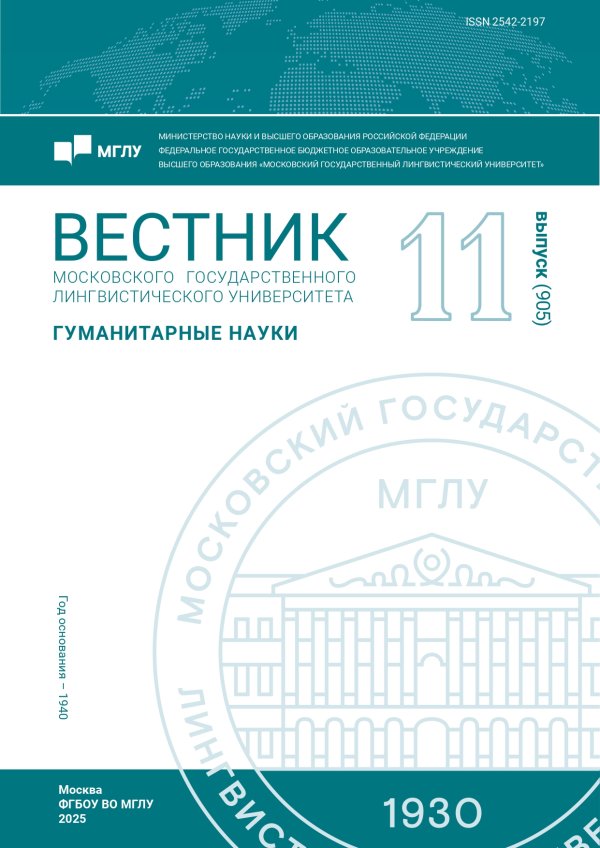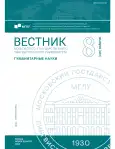№ 8(889) (2024)
- Год: 2024
- Статей: 22
- URL: https://journal-vniispk.ru/2542-2197/issue/view/19729
Языкознание
КОГНИТИВНЫЙ ДИССОНАНС КАК ТРИГГЕР КОГЕРЕНТНОСТИ В ПЕСЕННОМ ДИСКУРСЕ (НА МАТЕРИАЛЕ ПЕСНИ Л. КОЭНА "АЛЛИЛУЙЯ")
Аннотация
Исследование фокусируется на парадоксальной роли когнитивного диссонанса в качестве триггера когерентности. В ходе выявления когнитивного диссонанса в тексте песни Л. Коэна «Аллилуйя», анализа его распределения между строками и установлением связи между строфами, которые способствуют прояснению изначально неясных отрезков текста, исследователь приходит к выводу о том, что когнитивный диссонанс создает у читателя / слушателя потребность интерпретировать текст песни и тем самым обеспечивает его общую когерентность.
 9-16
9-16


РАСОВО-ЭТНИЧЕСКИЕ ЭВФЕМИЗМЫ КАК СРЕДСТВО РЕАЛИЗАЦИИ ПРИНЦИПА ПОЛИТИЧЕСКОЙ КОРРЕКТНОСТИ В СОВРЕМЕННОМ АНГЛИЙСКОМ ЯЗЫКЕ
Аннотация
В статье расово-этнические эвфемизмы английского языка рассматриваются с точки зрения их лексико-семантических и структурных особенностей, средств и способов образования. Автор анализирует причины появления подобных политкорректных наименований. Полученные результаты свидетельствуют о том, что исследуемые эвфемизмы являются средством самоидентификации для различных расово-этнических групп и направлены на продвижение идеи равенства и инклюзивности.
 17-24
17-24


МЕДИЙНЫЙ ДИСКУРС США И РЕСПУБЛИКИ БЕЛАРУСЬ В АСПЕКТЕ ВЗАИМОДЕЙСТВИЯ КАТЕГОРИЙ МОДУСА И МОДАЛЬНОСТИ
Аннотация
В статье рассматриваются особенности взаимодействия категории модальности с модусными категориями оценки, экспрессивности и эмотивности в медиадискурсе США и Республики Беларусь. Результаты лингвостилистического, контекстуального и сопоставительного анализа с опорой на анализ словарных дефиниций свидетельствуют об актуализации модальных значений возможности в простых модально-модусных комбинациях, в то время как для сложных модально-модусных комплексов более характерными являются модальные значения волеизъявления.
 25-31
25-31


СМЫСЛОВЫЕ АСПЕКТЫ ВИЗУАЛИЗАЦИИ В БРИТАНСКОМ ДРАМАТУРГИЧЕСКОМ ТЕКСТЕ
Аннотация
В статье рассматривается специфика смыслоформирования в британском драматургическом тексте. Исследование показало, что потенциальная сценичность (театральность) как жанроспецифическое свойство обусловливает понимание смысла воспроизводимых событий в пьесе. В ходе работы было выявлено и проанализировано лингвокогнитивное явление визуализации, которое имеет смысловые основания и выступает в качестве условия, оптимизирующего понимание смысла.
 32-37
32-37


ПЛАЧ В АНГЛИЙСКИХ УСТОЙЧИВЫХ ВЫРАЖЕНИЯХ
Аннотация
В статье анализируются устойчивые выражения, вербализующие идею плача, а именно: словосочетания, в которых встречается лексема cry. В ходе исследования были описаны пути трансформации значения идиом (от прямого до переосмысленного) и выявлены когнитивные механизмы, участвующие в создании фрагмента английской языковой картины мира и формирующие словосочетания различной степени устойчивости. В работе применены методы: сплошной выборки, дефиниционного и компонентного анализа.
 38-44
38-44


СКАЗОЧНЫЕ МОТИВЫ В РУССКОЯЗЫЧНОМ МИСТИЧЕСКОМ ДЕТЕКТИВЕ
Аннотация
В статье предпринимается попытка анализа языкового материала, способствующего вербализации сказочного мотива в современном русскоязычном мистическом детективе. При этом устанавливается наличие ограниченного количества артефактов, формирующих мистическую атмосферу в произведениях детективного жанра, к наиболее частотным из которых следует отнести «кровь», «веретено», «колодец», «медальон» и др. Указанные лексемы могут использоваться по усмотрению автора мистического детектива как для создания жизнеутверждающей атмосферы в тексте, так и для формирования атмосферы страха и неизбежности возмездия за каждый нелицеприятный проступок.
 45-51
45-51


ВРЕМЕННЫЕ ДЕТЕРМИНАНТЫ И АСПЕКТУАЛЬНАЯ АСИММЕТРИЯ - КОРПУСНОЕ ИССЛЕДОВАНИЕ
Аннотация
Цель статьи - описание случаев аспектуальной асимметрии (Imparfait - совершенный вид; Passé Simple / Passé Composé - несовершенный вид) в контекстах с временными детерминантами depuis longtemps, longtemps, pas longtemps avant, il y a longtemps, взятых из французских литературных произведений и их русских переводов. Для достижения поставленной цели было произведено ручное аннотирование контекстов в надкорпусной базе данных глагольных форм с последующим анализом. Корпусный подход к изучению аспектуальности в данной паре языков составляет актуальность статьи.
 52-59
52-59


ОСОБЕННОСТИ ПОЛИМОДАЛЬНОЙ КОММУНИКАЦИИ В ЖАНРЕ "ПИСЬМО РЕДАКТОРУ"
Аннотация
В статье рассматривается взаимодействие вербального, визуального и звукового модусов коммуникации для создания аргументативного пространства письма редактору. Анализ писем из журнала «The Economist» показал, что предваряющие текст изображения выполняют такие важные функции, как эстетическая и структурирующая; их дополняет расстановка смысловых ударений и пауз при озвучивании текста. При этом достигаемый аргументативный эффект может быть использован в этически неоднозначных целях.
 60-68
60-68


АНГЛОЯЗЫЧНЫЙ ДИСКУРС ДИСТАНЦИОННОГО ОБРАЗОВАНИЯ КАК МУЛЬТИМОДАЛЬНЫЙ КОНСТРУКТ
Аннотация
В статье предпринята попытка определить понятие «дискурс дистанционного образования». Предлагается его рассмотрение как мультимодального конструкта. Лексический уровень англоязычного дискурса дистанционного образования характеризуется широкой представленностью единиц, номинирующих агентов и клиентов дискурса, процесса обучения, служб и структуры обучения и т. д., составляющих основные номинативные группы дистанционного образовательного процесса. Авторы исследования также представляют анализ невербального и визуального уровней дискурса дистанционного образования.
 69-75
69-75


НЕЧЕТКАЯ РЕФЕРЕНЦИЯ В РЕЧИ И ЖЕСТЕ: ИЗУЧАЕМЫЙ И РОДНОЙ ЯЗЫКИ
Аннотация
На материале экспозиторных монологов сравниваются особенности конструирования понятий в речи и жестах в изучаемом языке (английском) и в родном языке (русском). Результаты обнаруживают сходство в распределении языковых средств нечеткой референции и разных типов жестов, что подтверждает наличие общих дискурсивных паттернов полимодального конструирования понятий. Однако превалирование в изучаемом языке заместителей, сопровождающихся репрезентирующими жестами, указывает на проблему лексического поиска, в решении которой принимают участие жесты.
 76-84
76-84


МОДЕЛИ МЕТАФОРИЗАЦИИ ОЦЕНОЧНЫХ ЗНАЧЕНИЙ
Аннотация
В статье исследуются репрезентанты концепта «общая оценка» на примерах из Британского национального корпуса. Выявляются модели, по которым осуществляется метафоризация общеоценочных значений мелиоративного и пейоративного характера. Показано, что общеоценочные предикаты, возглавляющие синтаксические конструкции, представляют собой свернутые концептуальные метафоры, однозначно квалифицирующие объект оценки в аксиологическом плане, тогда как неметафоризованные варианты оценочных суждений нуждаются в дополнительной экспликации.
 85-91
85-91


ЛИНГВОКРЕАТИВНОСТЬ В АНГЛОЯЗЫЧНЫХ ГАЗЕТНЫХ ОНЛАЙН-КОММЕНТАРИЯХ: ИНТЕРПРЕТАЦИЯ И КОГНИТИВНЫЙ ДИССОНАНС
Аннотация
В статье, изучающей актуальные вопросы проявления лингвокреативности, показано, что манифестация лингвокреативности в англоязычных комментариях пользователей сайтов официальных средств массовой информации связана с самореализацией личности комментирующего через субъективную интерпретацию им первичного текста. Лингвокреативная природа когнитивного диссонанса реализуется в онлайн-комментариях, вербализующих интерпретации, противоречащие интерпретациям, представленным в комментируемых текстах.
 92-98
92-98


К ПРОБЛЕМЕ КОНФИГУРАЦИИ КОДОВ В СЕМИОТИЧЕСКИ ОСЛОЖНЕННЫХ ТЕКСТАХ (НА ПРИМЕРЕ МЕМОВ МУЗЫКАЛЬНОЙ ТЕМАТИКИ)
Аннотация
В предлагаемой статье рассматриваются единицы интернет-коммуникации, а именно мемы, встречающиеся в профессиональной сфере музыкантов. К используемым в них единицам смыслообразования относятся визуальные, вербальные средства, а также средства нотной записи. Исследование сфокусировано на анализе различных кодов - компонентов мема, выраженных тремя семиотическими системами. В центре внимания находятся конфигурация кодов, способы их прочтения и обеспечение когерентности поликодовых мемов.
 99-107
99-107


ИКОНИЧЕСКИЕ СТРАТЕГИИ ПОСТРОЕНИЯ АНГЛОЯЗЫЧНОЙ АВТОРСКОЙ СКАЗКИ
Аннотация
В статье рассматривается актуальный объект исследования - авторская сказка, отражающая и фиксирующая основополагающий человеческий опыт. Иконические стратегии, создающие 3D-пространство вымышленного мира сказки, описываются как средство создания связного нарратива авторской сказки при ее кажущейся фрагментарности и постижения ее глубокого смысла. Продуктивность исследования сказочного повествования подтверждена проведенным анализом аутентичного текста англоязычной авторской сказки.
 108-114
108-114


ПРАГМАТИКА ПОЛИТИЧЕСКОЙ ПУБЛИЧНОЙ РЕЧИ: СТИЛИСТИЧЕСКОЕ ИЗМЕРЕНИЕ (НА МАТЕРИАЛЕ ВЫСТУПЛЕНИЙ ПРЕЗИДЕНТОВ США)
Аннотация
Главная роль в статье отводится изучению языка политической публичной речи в американской президентской коммуникативной культуре. Проанализированные тексты речей президентов США показали перспективность изучения маркеров языковой репрезентации категорий времени и пространства в сопряжении с приемами стилистического синтаксиса для выявления коммуникативно-прагматического и регулятивного потенциала политического выступления.
 115-122
115-122


ДИСКУРСИВНЫЙ СТАТУС И КОНЦЕПТУАЛЬНЫЕ ОСНОВАНИЯ ПАРАПРОСДОКИИ КАК СРЕДСТВА РЕАЛИЗАЦИИ ЭФФЕКТА ОБМАНУТОГО ОЖИДАНИЯ (НА МАТЕРИАЛЕ АНГЛОЯЗЫЧНОГО ДИСКУРСА)
Аннотация
В статье рассматриваются дискурсивные и концептуальные средства создания эффекта обманутого ожидания в англоязычном юмористическом дискурсе; обосновывается целесообразность использования термина «парапросдокия» применительно к дискурсивной реализации эффекта обманутого ожидания; анализируется дискурсивный механизм, лежащий в основе парапросдокии; делаются выводы относительно ее концептуальной структуры и взаимодействия с другими стилистическими приемами и экстралингвистической информацией.
 123-129
123-129


К ВОПРОСУ ОБ (АНТИ)КРЕАТИВНОСТИ МЕДИЙНОГО ДИСКУРСА
Аннотация
В работе предпринимается попытка выявить основные тенденции реализации лингвокреатем в медийном дискурсе. В результате дискурсивно-параметрического анализа текстов англоязычной прессы 1990-2022 годов. языковые единицы, обладающие лингвокреативным потенциалом, разделяются на малокреативные, антикреативные и высококреативные (оригинальные). Делается вывод об общеязыковом и дискурсивно-обусловленном характере реализации лингвокреативности.
 130-136
130-136


ЛИНГВОКУЛЬТУРНАЯ СПЕЦИФИКА МИФОЛОГИЗАЦИИ УТИЛИТАРНОГО И ДУХОВНОГО АКСИОЛОГИЧЕСКИХ ПРОСТРАНСТВ (СООТНОШЕНИЕ ПРАЛОГИЧНЫХ И РАЦИОНАЛЬНЫХ ЭЛЕМЕНТОВ)
Аннотация
В статье рассматриваются особенности мифологизации утилитарного и духовного аксиологических пространств эпических текстов. У разных народов они могут проявляться в зависимости от лингвокультурных особенностей и национальных традиций. В некоторых культурах утилитарное пространство может быть мифологизировано через религиозные или фольклорные представления о природе и связанные с ней символы. С другой стороны, духовное аксиологическое пространство может быть мифологизировано через представления о сверхъестественных существах, богах, духах или героях, которые влияют на жизнь людей и на окружающий мир. Эти представления зависят от религиозных верований и традиций конкретной культуры.
 137-143
137-143


Литературоведение
АХИЛЛЕСОВА ПЯТА VS ACHILLES’HEEL (СРАВНИТЕЛЬНЫЙ ИСТОРИКО-ЛИНГВИСТИЧЕСКИЙ И ЛИТЕРАТУРНЫЙ АНАЛИЗ ФРАЗЕОЛОГИЗМА)
Аннотация
В статье проводится исторический и литературный анализ происхождения ономастических фразеологизмов ахиллесова пята в русском языке и Achilles’ heel в английском. Цель исследования - установить причины этимологической разницы в словах, употребляемых в двух языках в выражениях, имеющих отношение к одному и тому же мифу.
 144-150
144-150


ДРЕВНЕИНДИЙСКИЕ СЮЖЕТЫ САНСКРИТСКОГО СБОРНИКА "КАРМАШАТАКА" В ОЙРАТСКОМ ПИСЬМЕННОМ ПАМЯТНИКЕ "СКАЗАНИЕ НЕКТАРНОГО УЧЕНИЯ"
Аннотация
В настоящей статье впервые предпринята попытка рассмотреть сюжеты из ойратского письменного памятника XVII-XVIII вв. «Сказание нектарного Учения» в сравнении с его источником, санскритским сборником «Кармашатака», переведенном в VIII в. на тибетский язык. В результате исследования установлено, что генетически близкие сюжеты из «Кармашатаки» помогают реконструировать и лучше понять содержание коротких рассказов из ойратского сборника, утративших свои существенные структурные компоненты в связи с несколькими стадиями переводов (ойратский < тибетский < санскрит), устной передачей и многочисленной перепиской текстов.
 151-157
151-157


Культурология
ПРОИЗВЕДЕНИЕ ИСКУССТВА КАК МИР В МАЛОМ В ТРАКТОВКЕ ЗЕДЛЬМАЙРА
Аннотация
В статье анализируются воззрения австрийского искусствоведа Зедльмайра, характеризующие онтологический статус произведения искусства. Произведение искусства рассматривается им не как форма или идея, а как модель бытия и как средство познания бытия. Поэтому оно существует только в момент актуализации или интерпретации, когда оно созерцается в личном экзистенциальном опыте как особое пространство и время. Согласно Зедльмайру, произведение искусства - это уникальная целостность, подобная мирозданию, мир в малом, в котором нет разделения на субъект и объект.
 158-164
158-164


МЕТАФИЗИКА ИСКУССТВА: ПЛАТОНИЧЕСКИЕ МОТИВЫ В ПРОИЗВЕДЕНИИ П. А. ФЛОРЕНСКОГО "ИКОНОСТАС"
Аннотация
В статье рассматривается работа П. А. Флоренского «Иконостас». Проводится компаративистский анализ взглядов Платона и отца Павла на вопросы философии изобразительного искусства. Рассматриваются такие понятия, как культ, культура, икона и символ в философской системе Флоренского. Нравственный аспект определяется как важнейший в процессах познания и творчества. Анализируется выстраиваемая Флоренским парадигма истории искусства, ключевым в которой становится духовный вектор человеческой деятельности. Русская иконопись XIV-XV веков признается высшим достижением духовной и изобразительной культуры. Период эпохи Возрождения определяется как отход от культа и установление вектора на секуляризацию.
 165-172
165-172












